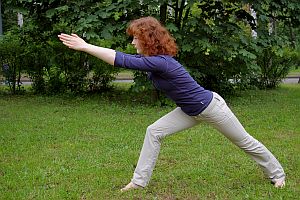What Causes Muscle Tension?

Muscle tension occurs when a muscle (or group of muscles) remains contracted for an extended period of time. This might be characterized as a low-energy or low-intensity muscle cramp. Such tension in the muscles constricts blood flow, which in turn keeps oxygen and nutrients from reaching the muscle tissues and tendons. Muscle tension also keeps cellular waste from being carried away. The result is more muscle tension, spasms and damage. Why does this happen? There are actually several possible causes.
One key source of muscle tension is stress or anxiety. For our ancient ancestors, stress was a simple fact of everyday life, and their ability to response effectively to imminent threats (predators, hostile neighbors, natural disasters, etc.) was an integral part of their survival. As a result, their bodies evolved a set of short-term physiological changes that helped them to meet sudden life-and-death challenges by increasing their alertness, strength, speed and stamina. Today, we refer to these changes collectively as the “fight-or-flight” response, and they’re part of our evolutionary inheritance.
Unfortunately, there is now a kind of mismatch between the kinds of modern threats (real or perceived) that most of us encounter in our day-to-day lives and our bodies’ primitive fight-or-flight response. Instead of short-term physical dangers, modern stress is much more likely to come from social or financial pressures that are (usually) lower-intensity but more prolonged. Mounting bills, insane work deadlines and relationship problems are all great examples. This is a problem because our fight-or-flight response was really designed to be “switched on” only for very short periods of time—essentially, just as long as it took us to either defend ourselves or escape from a physical attack. It turns out that the human body pays a high price for the fight-or-flight response, and this price is especially high when the response is activated continuously over long periods of time, even at relatively low levels. Chronic muscle tension is just one potential result.
Muscle tension can also be the result of underlying structural problems or injuries affecting the musculoskeletal system, especially in the back or neck. When the spine is misaligned or there is an injury, the body may compensate by activating other muscles or muscle groups to stabilize the area and prevent pain. These muscles are put under additional strain for which they were not designed, leading to chronic muscle tension.
Chronic muscle tension itself can lead to new kinds of discomfort and pain. The pain can lead to an increase in anxiety and more muscle tension. This becomes a vicious cycle—an unhealthy, downward spiral. Luckily, there are a number of different ways to relieve muscle tension.
One of the best ways to relax your muscles is to exercise. This may seem counterintuitive at first, but muscle use increases blood flow and, accordingly, reduces the tension caused directly from lack of such blood flow. Exercise also produces endorphins which help to relieve stress and anxiety.
Heat is another method of relief. It can help by opening up blood vessels and relaxing the tense muscles. Use care when applying a hot pack. With heat, you can do too much of a good thing. Use a cloth between the pack and the skin so the heat remains measured and soothing. If you use an electrical heating pad, do not lie on the pad, but lay the pad on the tense muscles.
Water therapy can also help reduce muscle tension. Floating in a swimming pool or on a waterbed can prove to be extremely therapeutic because of the relaxing nature of wave action on the body.
Of course, a massage therapist is an expert at helping muscles relax. A truly good therapist can adapt his or her technique to your specific situation and will be skilled at gradually building up the intensity of the massage so that you’ll receive all the therapeutic benefit without losing the relaxation benefit.
Remember—it’s important to understand the underlying cause of chronic muscle tension so that it can be addressed in an effective way. Your chiropractor is specially trained to determine if the underlying cause is structural. If it is, he or she may be able to perform adjustments to correct the problem. Depending on your specific situation, your chiropractor may also recommend a treatment plan that includes several of the therapies mentioned above in order to relieve your pain and restore your mobility as quickly as possible.
 Everyone deals with stress in their lives. And—in small doses—this can be a very good thing. Manageable amounts of stress can actually help you perform at your best and may even help you develop your abilities. However, far too many of us are stressed to the point that our health and well-being could be compromised.
Everyone deals with stress in their lives. And—in small doses—this can be a very good thing. Manageable amounts of stress can actually help you perform at your best and may even help you develop your abilities. However, far too many of us are stressed to the point that our health and well-being could be compromised.
 If you are middle-aged (40-60, by some definitions) or older, here’s 15-second self-test for you. Do you often find yourself needing to sit down or steady yourself against a table when putting on your shoes or stepping into pants? Do you increasingly need to use the armrests of your chair to “push off” when getting up? Do you generally hold on to handrails whenever you go up and down stairs? If you stand with your feet close together, do you feel unsteady and unable to balance yourself properly?
If you are middle-aged (40-60, by some definitions) or older, here’s 15-second self-test for you. Do you often find yourself needing to sit down or steady yourself against a table when putting on your shoes or stepping into pants? Do you increasingly need to use the armrests of your chair to “push off” when getting up? Do you generally hold on to handrails whenever you go up and down stairs? If you stand with your feet close together, do you feel unsteady and unable to balance yourself properly?
 Do you want to become healthier and stay healthy longer? Take a walk. That is the message of two important new studies.
Do you want to become healthier and stay healthy longer? Take a walk. That is the message of two important new studies.


 There are quite literally hundreds of different brands of nutritional supplements (also called dietary supplements) on the market today, and it’s difficult for the average consumer to tell the difference between one and another. Each manufacturer claims that its products are supportive of your health, but how can you really determine if a nutritional supplement is safe and effective? Then there’s the price tag. Brands vary considerably in cost—one multivitamin may cost 20 cents per day, whereas another can cost a whopping $7.50! How can you decide whether it’s worth it? Our goal is to provide you with some practical advice—basic facts combined with a few do’s and don’ts—that you can use to be a more educated consumer if you decide to buy nutritional supplements.
There are quite literally hundreds of different brands of nutritional supplements (also called dietary supplements) on the market today, and it’s difficult for the average consumer to tell the difference between one and another. Each manufacturer claims that its products are supportive of your health, but how can you really determine if a nutritional supplement is safe and effective? Then there’s the price tag. Brands vary considerably in cost—one multivitamin may cost 20 cents per day, whereas another can cost a whopping $7.50! How can you decide whether it’s worth it? Our goal is to provide you with some practical advice—basic facts combined with a few do’s and don’ts—that you can use to be a more educated consumer if you decide to buy nutritional supplements.